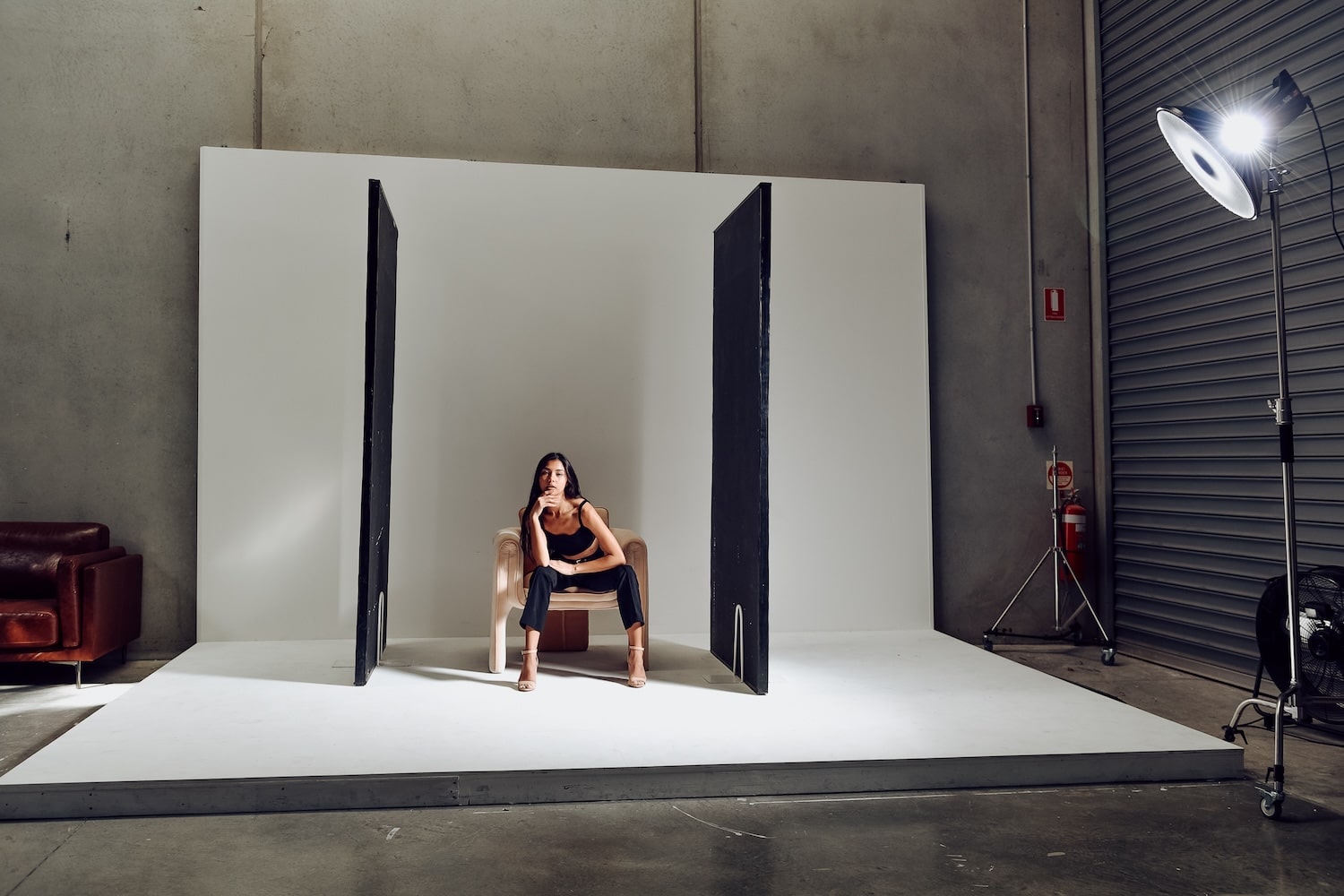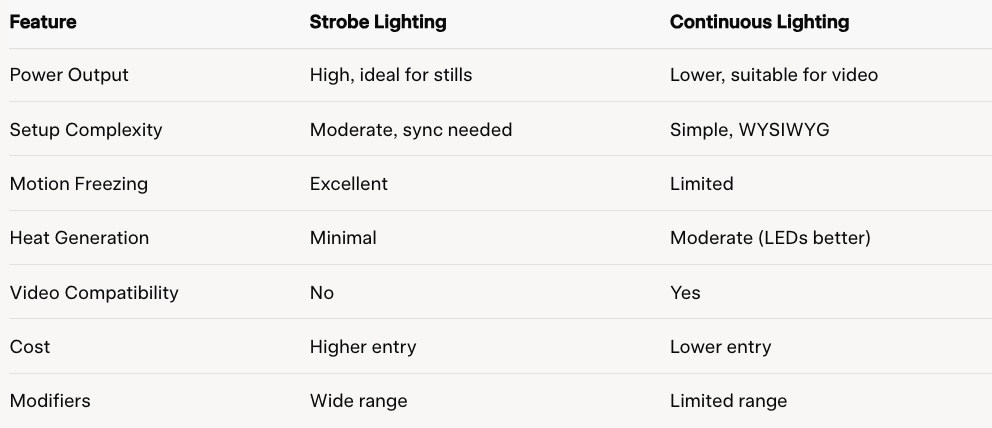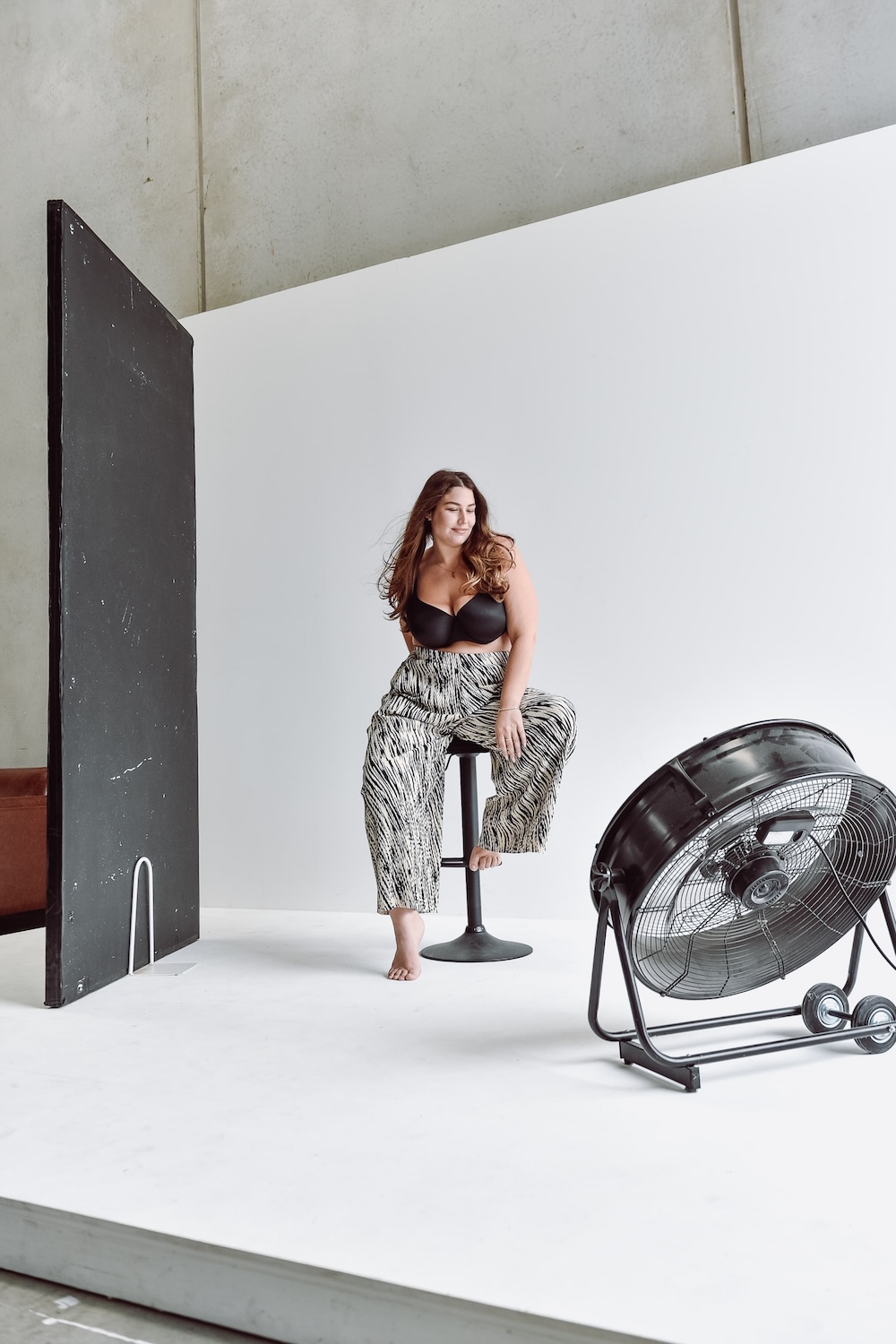Confused between strobe and continuous lighting? Learn the pros, cons, and best uses for portraits, products, and video to light your studio like a pro.

Strobe vs continuous lighting is a key decision for photographers. Strobes deliver powerful bursts for stills, while continuous lights offer real-time previews for photos and video. This guide compares their differences, advantages, and ideal use cases to help you choose the right lighting for your studio. Whether you’re shooting portraits, products, or video, understanding these tools ensures consistent, high-quality results.
Continuous lighting in photography stays on, delivering steady illumination like a video light. It provides a WYSIWYG experience, allowing real-time adjustments for stills or video, with adjustable power for versatile setups.
Strobe lighting refers to short, intense bursts of light. Photographers use strobes (flash units, monolights, pack-and-head systems) to freeze motion, shape light with modifiers, and get high output without constant heat. The light fires only when you press the shutter, which gives you power without continuous load. The modelling lamp shows approximate light but is not the final output.
Continuous lights stay on, providing real-time previews for photography and video. Strobe lights emit short, intense bursts, ideal for freezing motion and high-output stills. Continuous is beginner-friendly; strobes offer more power and modifier versatility.
A strobe is any light producing bright bursts, including monolights and pack-and-head systems. Monolights are self-contained strobes with power, flash, and modelling light in one unit, offering portability and simplicity over multi-component systems.
The three main types of continuous lighting are LED (energy-efficient, adjustable), tungsten (warm, affordable), and fluorescent (cool, daylight-balanced). LEDs are most versatile, while tungsten and fluorescent suit budget-conscious setups.
Examples of continuous lighting include LED panels (e.g., Godox COB LEDs), tungsten lights (warm, budget-friendly), and fluorescent bulbs (cool, daylight-balanced). These provide steady illumination for photography and video.
Continuous light gives immediate feedback. You see shadows, falloff, and catchlights live. That makes it faster for beginners or when you’re directing models. Strobes require understanding sync speed, power ratios, and interpreting the modelling light vs actual flash.
Strobe wins here. The flash duration is very short, so it can freeze movement cleanly even at moderate shutter speeds. Continuous lights rely on ambient exposure time; to freeze motion you need high output or very fast shutter speeds, which isn’t always possible without compromising ISO or aperture.
Continuous lighting gives a true WYSIWYG experience. You set light, watch how it affects the subject, and adjust. With strobes, the modelling lamp is only an approximation; you often need test shots to confirm.
Strobes deliver a lot of light in short bursts. For stills, that means high output without needing long exposures. Continuous lights, especially quality LEDs have improved, but to match strobe flash power for deep shadows or high-speed work usually requires significantly more expensive units.
Modern LED continuous lights run much cooler than older tungsten units, but they still emit more constant heat than strobes when the strobe is idle. If the strobe’s modelling lamp is left on it can get warm, but overall strobes are less heat-intensive during a shoot.
High-quality strobes tend to have very consistent colour temperature and high colour accuracy across power levels. Continuous LEDs vary by build quality; cheaper units can shift in temperature under load or over time. Good LEDs mitigate this, but strobes still edge out for predictable output on serious commercial work.
Continuous lighting is the only option for video. Strobes are too fast and intermittent; you can’t light moving footage with flash. Hybrid content creators often keep a set of adjustable continuous lights for motion plus strobes for still captures.
Continuous lighting has lower output than strobes, requiring higher ISOs or slower shutters, risking noise or blur. Older models (e.g., tungsten) generate heat, discomforting subjects. They’re less effective outdoors and less portable due to constant power needs.
Continuous lighting offers real-time previews, simplifying setup for beginners. It’s ideal for video, requires no triggers, and supports multiple shooters. Modern LEDs are battery-powered, portable, and adjustable for colour temperature.
Photographers use flash (strobes) for higher power output, ideal for outdoor daylight or freezing motion. Strobes offer better depth of field control and modifier versatility, unlike continuous lights, which are dimmer and less effective outdoors.
Strobes are better for high-power stills, freezing motion, and deep depth of field without high ISO. Continuous lights excel for video and real-time previews but lack strobe’s intensity and versatility for action shots.

Photographers use strobe lighting for powerful bursts to light group shots, freeze motion, or overpower ambient light. Strobes support creative effects with diffusers and modifiers, maintaining image quality for product or portrait photography.
Yes, continuous light is excellent for photography, especially still life, portraits, and product shots. Its real-time preview simplifies setup, and it’s user-friendly for beginners, delivering consistent results without flash sync.
Many studios use both. You can shape a key with continuous light to position talent, then fire strobes for final exposure. Some LED panels now mimic flash output for testing ratios before switching to strobes.
Strobes are better for high-power stills, freezing motion, and deep depth of field without high ISO. Continuous lights excel for video and real-time previews but lack strobe’s intensity and versatility for action shots.
Yes. If you have enough output and control, continuous light can deliver sharp product images. It’s slower for freezing motion, so you may need longer exposures or a tripod.
If you do mixed work (still plus video, or directing talent), having both gives flexibility. You can prep with continuous and finish with strobes.
Monolights, pack-and-head strobes, and speedlights are common. They vary by recycling speed, power, and ease of modifier attachment.
Strobe lighting and continuous light for photography serve different needs. Pick the one that fits the shoot, or combine both for maximum control. Start with what you need to solve now: direction, motion, or video and layer in the other as your workflow evolves.

